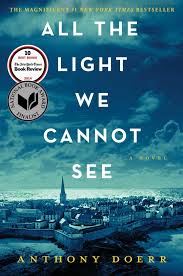“Every hour, she thinks, someone for whom the war was memory falls out of the world.”
We tend to think of World War II as defined by its sweeping heroism: terrified soldiers fishtailing on the beaches of Normandy; unbowed Londoners during the Luftwaffe bombings, to name two; and its equally sweeping atrocities: sailors entombed beneath Pearl Harbor; the unspeakable extermination of innocent Jews. We all know the versions of WWII told by Hollywood and history books. But the reality of this war also encompassed millions of unheralded, more prosaic stories.
There are two main characters in All The Light We Cannot See: a blind French girl, Marie-Laure Leblanc, and an orphaned German boy, Werner Pfennig. Marie-Laure lives with her father, a museum locksmith, in Paris. At the onset of the Occupation, they flee into the French countryside, enduring a journey of horrific deprivation to reach the coast. Marie-Laure’s father has relatives in the town of Saint-Malo, and they wind up in his uncle Etienne’s home overlooking the sea, where Marie-Laure finds her own small role in the Resistance. As the war progresses, necessities fall away from Marie-Laure one by one: her home, her safety, her loved ones, even food and water. In the last days of the war, the skies above Saint-Malo are raining mortar shells; the city is under siege by the Americans. If that is not enough, sightless Marie-Laure, the unwitting bearer of a valuable and dangerous jewel from her father’s museum, is being hunted by a German officer as the ancient city collapses around her. Her chance of survival seems as fragile as a filament of spiderweb.
Meanwhile, Werner lives with his sister Jutta in an orphanage in a coal-mining region of Germany. A bright, inquisitive boy, he is fascinated with physics and machinery, especially radios, but he understands that young men in his position have only one option in life: to work in the mines. But times are changing in Germany. There is an inexorable current of conformity sweeping the nation, a jingoistic fervor that engulfs Werner’s countrymen and slowly transforms the population into two groups: the accepted and the inferior. When the Hitler Youth arrive to cull the ideal Aryan boys away from the substandard specimens, Werner—with his sky-blue eyes, fluorescent blond hair and analytical intelligence—is selected. Suddenly he is training to give his life to Fatherland. He parlays his gift with gadgets into a military position intercepting Resistance radio broadcasts. Traveling war-ravaged Europe, he ultimately lands in Saint-Malo, where at last his life intersects with Marie Laure’s.
A blind French girl, an orphaned German boy; two tiny, ordinary lives in a vast sea of continental upheaval. Will either of them will survive the war?
It sounds grim; I know. But this novel—the winner of the 2015 Pulitzer prize for fiction—is exquisite. It ties together physics and history and geology and sociology and so much more. It is lovely and intricate and transformative; you cannot come away from reading it as the same person you were when you began. Every page pulses with precise and lavish phrases so beautiful they almost seem to be written in an entirely new language. Even the title is tiered with layer upon layer of meaning: Werner’s obsession with the electromagnetic spectrum of radio waves outside visible light; Marie-Laure’s loss of vision; light-absorbing diamonds buried deep in the earth; and as the author himself notes: the “countless invisible stories still buried within World War II — stories of ordinary children, for example… a kind of light we do not typically see.”
All I could think after reading this novel was of the unfathomable multitude of changes that war creates. If you pan out from the vision of Marie-Laure and Werner, you see the millions of French and German lives irrevocably altered, or lost; then zoom further still to the British, the Polish, the Soviet Union—over 27 million dead there; an entire generation annihilated—the Italians, all the other Europeans, the Asians, the Americans, and of course Jews and others of every nationality— how many heart-wrenching individual stories must there be? It’s too overwhelming to contemplate. But Doerr’s writing forces you to contemplate it. It’s a beautiful book.
Title: ALL THE LIGHT WE CANNOT SEE
Author: Anthony Doerr
Genre: Historical Fiction.
Page count: 545
Kimmery’s ratings:
Prose style: 5++
Plot: 5
Character development: 5
Originality: 5
Entertainment value: 4


